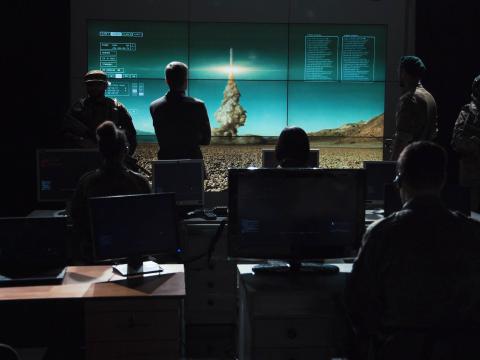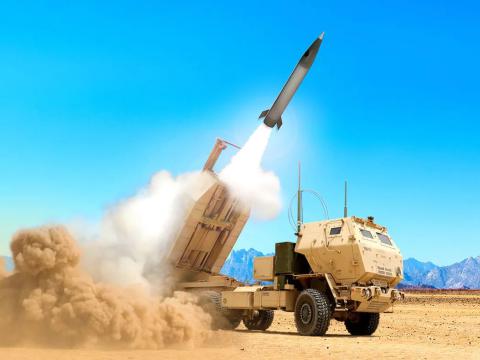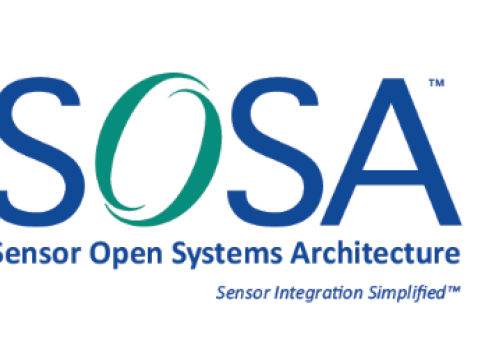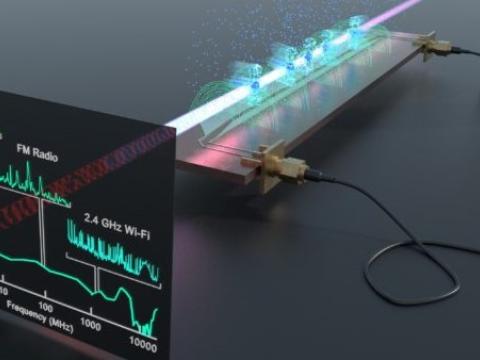New Eye in the Sky
Airborne surveillance, battle management platform surpasses existing systems.
The U.S. Air Force soon will field a new generation of command and control aircraft featuring advanced radar and communications systems. Designed around an open systems architecture, the aircraft can be easily refitted with new technologies as they become available. These platforms may combine both the capabilities of ground tracking and surveillance with airborne early warning functions some time in the future, Air Force officials say.
Coordinating actions across a wide theater of operations is a hallmark of modern warfare. The U.S. military enjoys a considerable advantage in battlefield command and control (C2) because of its fleets of E-3 Sentry airborne warning and control system (AWACS) and Joint Surveillance Target Attack Radar System (Joint STARS) aircraft. But the need is growing for aircraft that can rapidly detect and counter emerging threats such as advanced cruise missiles.
To meet these challenges, the Air Force is developing and fielding aircraft with a next-generation multisensor C2 suite. The goal of the multimission command and control aircraft (MC2A) program is to develop an advanced wide-area surveillance platform featuring enhanced sensor fusion between systems for command, control, communications, computers, intelligence, surveillance and reconnaissance (C4ISR) functions.
According to Lt. Col. Tracy E. Tynan, USAF, chief of the C4ISR future capabilities division in the Air Force Assistant Secretary for Acquisitions Office, Washington, D.C., the current generation of platforms such as AWACS, Rivet Joint and Joint STARS has a number of limitations. “Essentially you’ve got lots of data coming into these things, and the effort to turn it into useful, relevant, timely information is the challenge,” he says.
The original vision of the program was to fold all of the capabilities of the AWACS, Joint STARS, Compass Call, Rivet Joint, U-2 and Airborne Command and Control Center aircraft into the MC2A and a constellation of high- and low-altitude unmanned aerial vehicles. While this goal may be achieved in the future, the program’s initial development cycle calls for developing and fielding ground surveillance, targeting, C2 and battle management capabilities similar to Joint STARS.
According to the defense analysis firm Global Security.Org, a future development spiral would combine the AWACS airborne watch mission with the Joint STARS ground surveillance capability. However, Air Force officials indicate that the technology is not mature enough to combine both functions today.
The heart of the system is a large, active, electronically scanned array radar. This advanced radar is about 20 feet long and about four feet high, much larger than the radar on Joint STARS aircraft, the colonel says. It is a larger scale version of systems developed for the F-22 Raptor and the Joint Strike Fighter, and it offers a greater capability to conduct the ground-scanning and search mission of the Joint STARS fleet. The ability to scan the ground at low altitudes enables the MC2A radar to detect cruise missiles. Col. Tynan notes that effective cruise missile defense cannot be done adequately by any of the Air Force’s existing surveillance platforms.
Depending on its configuration, the MC2A’s radar and sensor can track both airborne and ground moving target indicators (AMTI, GMTI). AWACS aircraft are configured to detect AMTI, whereas Joint STARS platforms locate GMTI, notes Maj. Henry Ceyr, USAF, program element monitor for the MC2A multiplatform radar technology insertion program, Washington, D.C. In its current configuration, the MC2A radar can track GMTI and some airborne objects such as low-flying cruise missiles. The major refers to this as focused AMTI.
Although both ground and air C2 functions may one day be combined into a single aircraft, Maj. Ceyr notes that full AMTI and GMTI functions cannot yet operate on the same platform, and issues such as sensor and systems interference must be resolved before this can be achieved, he says.
The MC2A’s radar will be a significant improvement over those used in the Joint STARS fleet, Col. Tynan explains. Besides having an advanced GMTI capability, it will fuse sensors into what the colonel refers to as the command and control constellation—a group of interconnected communications, surveillance and battlefield management systems scheduled to enter operation by 2012.
These sensor and data applications will be integrated into the MC2A program to create a system with enhanced sensor fusion and data integration capabilities, Col. Tynan says. While current platforms such as AWACS must share data on a point-to-point basis, the MC2A will provide commanders with an enhanced picture of the battlespace.
The MC2A is designed with an open systems architecture to permit other technologies under development to be inserted into the airframes once they become mature. The aircraft will be installed with a fiber-optic backbone to ease the installation of future equipment. Among the variety of systems scheduled for integration into the aircraft are the fruit of programs such as network-centric collaborative targeting, the family of beyond-line-of-sight terminals, the joint tactical radio system and Link-16. “All of those pieces are the things that will allow us to fuse the sensors on the back of the aircraft,” the colonel says.
Under its current development spiral, the initial batch of five MC2A-2A aircraft is slated for delivery in 2013. This number includes four operational and one test and evaluation aircraft. The open architecture will allow program developers to take advantage of any additional technological developments that may take place during that time, Maj. Ceyr says.
Besides providing enhanced C2 functions for the military, the MC2A-2A aircraft will form the lead elements in an effort to recapitalize the Air Force’s C2ISR fleet. But the major cautions that it is still early in the process. “We have to determine the existing life left on the platforms that are out there right now. How long do we expect an AWACS, Rivet Joint or Joint STARS to continue flying?” the major asks.
The answer to that question will determine whether the Air Force moves to a smaller fleet of more capable aircraft. The major notes that intuitively, it would be logical to do so if the technology permits. But because of the challenges involved in combining a wide variety of sensors and systems on a single platform, the Air Force will probably have to operate different platforms for ground and air command and control for some time. Maj. Ceyr notes that deciding which technologies will go on next-generation platforms like the MC2A-2A presents more immediate concerns than does modifying fleet numbers. “So if we could get to the stage where you have two sensors on one airplane, then you could certainly reduce the numbers [of aircraft]. If it takes a while to get there, then it certainly would not help us to go down that path right away,” he says.
Another important factor in the program was selecting the right aircraft. The program’s initial testbed aircraft was a modified Boeing 707 called the Paul Revere. However, the aircraft was not large enough to house the MC2A radar array, Col. Tynan observes. The 707 carried out C2 and tactics concepts and demonstrations.
The aircraft selected for the full MC2A system is the Boeing 767-400 series. Compared with the 707, the 767 is a new aircraft widely used by civilian carriers. The colonel explains that, besides its capacity to hold all the planned sensor equipment, the air craft shortens the Air Force’s logistical tail. Because of its wide availability in the commercial sector, it may be possible for the service to use commercial parts available at civilian airports during an operation. This cannot be done with its existing 707s because most of those aircraft have been retired from commercial service.
Col. Tynan notes that the full initial deployment of the aircraft has been funded. The primary effort is to ensure that the entire systems suite is built, including the aircraft’s sensor and C2 systems. He adds that only the first spiral of the program has been planned and fielded. Future spirals currently are unfunded and will be based on the technology available at the time, but the colonel is sanguine about the prospects of these new applications.




Comments